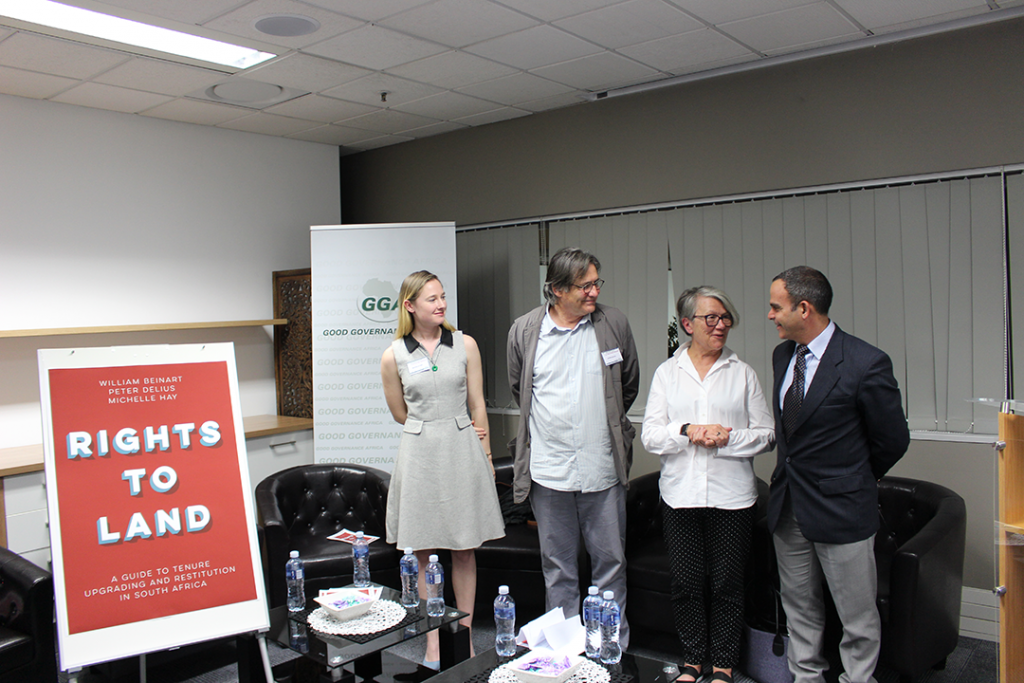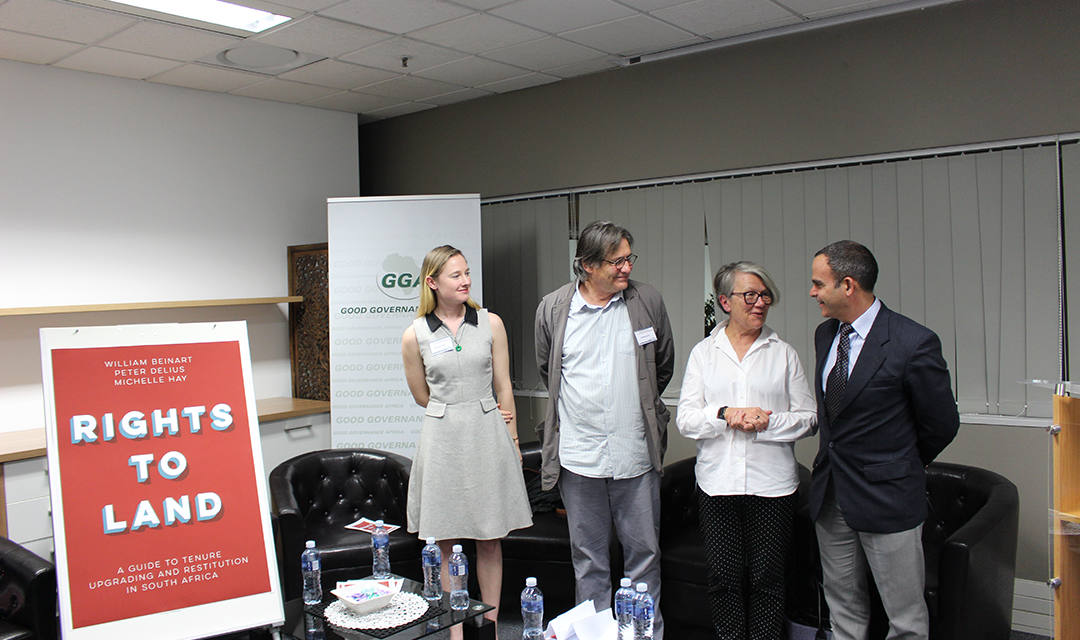
At the launch of the GGA publication Rights to Land, from left to right, authors Michelle Hay, and Peter Delius, Bridget Impey, publishing director of Jacana Media, GGA Executive Director Alain Tschudin, and author William Beinart. Image Lloyd Coutts
Land issues are being debated intensely and there are a number of interesting new developments: a new presidency of the ANC; a pending Restitution Amendment Act at present invalidated by the Constitutional Court; the High-Level Panel report to parliament; a new Communal Tenure Bill; and a land audit by AgriSA.
Cyril Ramaphosa, now President of the ANC, has specifically addressed land issues on a few occasions since his election in December 2017. He has, following a resolution at the ANC conference, raised the possibility of expropriation of white-owned land without compensation as well as radical socio-economic transformation in relation to land: “The land question,” he is quoted as saying, “must be resolved … Land needs to brought back to its rightful owners. We must find solutions.”
He and the ANC have, however, also articulated some caution. Firstly, Ramaphosa said that radical transformation should be in the interests of the people and not a few individuals.
Secondly, in recognition of widespread failure to maintain production on transferred land, he said: “Government must not give land back and stand by. Government must work with people hand in hand to support them.”
Thirdly, the resolution on land at the ANC conference specified that “such redistribution does not negatively impact on the agriculture, food security or other sectors such as financial services, which hold around 70% of commercial farmers’ debt”. These provisos were reinforced by Ramaphosa: “We must ensure we do not undermine the economy, agricultural production and food security. That is what is important. The ANC has always taken care to seek to manage the economy of our country in a way that seeks to advance our people… We will manage the implementation of this with due care.”
Depending on how they are interpreted, these could be very major constraints on a more rapid redistribution. This tension has long been at the heart of the ANC’s dilemmas in relation to land reform and a factor in their wisely cautious approach up to now.
Ramaphosa appears to accept the dangers of rapid land reform guided by policies designed to rectify injustices of the past without much regard to the consequences for production and food security. In a speech during his recent Eastern Cape trip, he seems to have come even closer to recognising some of the realities rather than engaging in the rhetoric of land reform. He noted that some of the farms transferred since 1994 were “derelict” and “not being worked”. A subsidiary question, that also came up at the ANC conference, concerns the tenure and control of land that is transferred – in particular the role of traditional authorities.
The shadow of Zimbabwe hovers around the South African debate. Does Zimbabwe teach us that a failure to address land reform can result in disaster? Or that a fast track land reform results in disaster? In Zimbabwe, land reform was highly successful until about 1997, when nearly 30 per cent of commercial farm land was transferred without any loss of production.
The government provided effective support to smallholders. After fast track land reform in 2000, maize production plummeted by more than half over a fifteen year period and tobacco production initially declined even more.
These were significant factors in the halving of the Zimbabwe’s GDP and the impoverishment of the country. Tobacco has now crept up again to its 1990s level but not to its peaks in the 1960s. Last year, in 2016-7, maize production probably reached 2 million tonnes or about the average of the 1980s.
But it was a particularly favourable year in which South African production reached its all-time high of about 17 million metric tonnes. The lesson we can draw from Zimbabwe’s experience is surely that the ANC should continue to err on the side of caution.
This is especially so because there is little evidence from South Africa that smallholders are maintaining or expanding production on the considerable areas of land they occupy. Nor is there much evidence that the South African state provides adequate back-up for smallholders.
Recent government statistics, and also a land audit by AgriSA, suggest that the pace of land transfers from white to black owners has increased significantly. The former homelands represented about 14-15 per cent of the land in 1994. Government reported last year that it had redistributed 9 per cent of the agricultural land, about 8 million ha, with compensation paid on another 2.7 million ha under the restitution programme.
Some sources suggested that another 4 million ha was owned by the state, although not all of it was available for land reform. In addition an unknown amount was privately purchased – perhaps 2-3 per cent. Together this amounts to around 26 per cent in black hands with additional land held by the state.
AgriSA employed researchers to examine every land transaction in the Deeds Office since 1994. They arrive at similar quantities: 27 per cent of agricultural land by area, 29 per cent by value and 46 per cent by potential for production is now held by ‘previously disadvantaged individuals’ and government. The reason for the latter figure is that most of the former homelands, and most of the transferred land, is in the wetter, eastern half of South Africa. According to their audit, over 70 per cent of agricultural land in KwaZulu-Natal is now occupied by black people. AgriSA suggest a higher percentage of privately transferred land than government, perhaps because such transactions have been underestimated or because some government-sponsored transfers did not pass through state ownership.
The status of government-owned agricultural land is not clear. The state is no longer transferring ownership of land to all black beneficiaries of the redistribution programme, but some of this state-owned land is probably occupied by such beneficiaries.
Although it is difficult to interpret the figures precisely, it is likely that black South Africans occupy 25-30 million ha out of a total area of about 93 million ha available for agriculture. This is a sizeable area; Zimbabwe as a whole is about 39 million ha. Malawi, including the lake, is only about 11 million ha yet its smallholders produce a great deal more maize than those in Zimbabwe or those in South Africa on larger areas of land.
The statistics on production for South Africa are by no means complete, firstly because there is no longer an annual agricultural census and secondly because figures are not effectively collected for smallholders.
Agricultural economists such as Ferdi Meyer point to a surprisingly successful growth in the value of output on privately-owned commercial farms over the ten years to 2015.
These are no longer all white owned. Despite the uncertainties caused by restitution and the removal of subsidies, production increased annually by about 2.5 per cent a year, which is less than China at 4 per cent and Chile at 3.5 per cent but more than major agricultural producers such as the United States, Russia and Mexico.
This is largely due to investment in higher value crops and associated processing, such as citrus, vines/wine, forestry, canola/rapeseed, beans and a wide range of fruit and vegetables.
Maize farmers suffered during the drought of 2015-6, but produced a record quantity in 2016-7 when the summer rains returned. Wheat, by contrast, has gradually declined since subsidies were removed in the 1990s and is hit by the Western Cape drought.
Sugar production has fallen but livestock has remained stable, with a rapid increase both in intensive poultry and extensive wildlife farms. Expanding wildlife farming on private land may have negative implications for food production, and this has become an issue for debate, but some wildlife farms use land that may be marginal for crops.
Information on smallholder output is inadequate and dependent largely on local studies. These point to some “pockets of dynamism”, especially on a few irrigation schemes, and in Limpopo and KwaZulu-Natal.
But the general picture is one of decline of arable output, with most activity now taking place in smaller gardens next to homesteads rather than in the old arable fields. Livestock are still largely farmed in small, free-ranging herds and flocks, dependent on the veld for fodder. It is easy to underestimate the value of smallholder livestock and chicken holdings, most of which is locally slaughtered and eaten. But there is still considerable scope for more intensive operations and better veterinary care.
This contrast should give pause for thought. Production has probably gone down in the former homelands since the 1980s – a trend that has not reversed over the twenty years since the democratic transition. New land can be of value to smallholders and communities in symbolic terms and especially in relation to extending livestock production.
In some cases, farms with high value investments, such as citrus, have been transferred. But much of the new transferred land is held by Communal Property Associations (CPAs) and Trusts, and these forms of collective ownership do not generally provide a successful framework for investment into agricultural production.
It is clearly critical to consider the impact of land transfers (and wildlife farms) on agricultural output as a whole because this is important for national food security, for the food and processing industries, and for export income. Some products are valuable in all these respects.
For example, South Africa is one of the world’s leading citrus exporters, but citrus is also enormously valuable in drinks, and as widely consumed, nutritious and relatively cheap fruit within the country.
This brief discussion underlines the dilemma faced in land reform policy and the tension that Ramaphosa expresses between a desire, on the one hand, to rectify the injustices of the past, when black people were disallowed from purchasing land, and, on the other hand, the need for pragmatism in order to prioritise production.
What sort of policy options might help to resolve this dilemma?
A first priority should be to follow the people and try to meet the most urgent demand for land, which appears to be for secure residential land and urban housing.
Urban incomes are, on average, higher; between the 2001 and 2011 censuses, the population of Gauteng and the Western Cape increased by about 3.8 million while that of three of the most rural provinces remained static.
RDP housing has been a significant achievement by the state but provision in the major conurbations still needs to get ahead of the curve and demand is also evident in medium sized towns.
Secure housing with title to the land and further prioritisation of services would go a long way to meeting both the rhetorical demand for land and urgent material needs.
The future of the restitution programme also needs to be clarified and it is important to distinguish between this policy, initiated in 1994, which requires legal proof of dispossession since 1913, and that of redistribution, in which the government buys land, or subsidises land purchases, for agricultural projects.
President Zuma prioritised restitution as an instrument for land reform and, without sufficient consideration of the consequences, passed the Restitution of Land Rights Amendment Act in 2014.
In the first phase of restitution 80,000 claims were made and some are still being resolved. 160,000 new claims were made in a couple of years before the Constitutional Court invalidated the Amendment Act in 2016.
Restitution was a valuable short-term response to the injustices of the apartheid era and resources should certainly be focused on resolving the outstanding claims under the 1994 Act.
But it was not intended as a long-term policy and is not conducive to enhancing production and rural incomes. Given current government propensities, a new phase of restitution might well see land transferred to chiefs in large claims.
It will be difficult to withdraw from this policy but the consequences may be an extended period, lasting decades, of instability in the countryside and an ethnicisation of rural politics. At this moment, a critical policy aim should be to keep capital and investment on the land.
As an alternative, the government could articulate and define a clear and specific policy around gradual redistribution that prioritised production and was specific about the areas to be affected. The large farm sector does not require subsidy but would greatly benefit from more certainty in order to encourage investment. Within corporate-owned enterprises, such as sugar and forestry, and many processing industries, there are clearly further opportunities for deracialisation and training. Land tenure is also an important area for discussion if the redistribution programme is to succeed.
The Communal Land Tenure Bill published in 2017 provides for a number of different outcomes, but seems to lean towards collective ownership, both through traditional authorities and CPAs. In a recent book, Rights to Land (Jacana, 2017), Beinart, Delius and Hay argue for a focus on stronger family and individual rights.
With respect to agricultural land and agriculture, the state’s priority should now be on unlocking the productive potential of the areas that are already occupied by those who suffered discrimination in the apartheid era. Innovative programmes are needed for smallholders where they hold land, as well as support for those who have recently moved onto transferred land.
If AgriSA is correct to estimate this area as including over 40 per cent of the country’s agricultural land, measured by its productive potential, then gains could be very considerable and contribute to those elusive goals of increasing rural wealth and employment.
This is not the place for a detailed discussion of existing or new projects but it is unlikely that the state acting alone will make much impact. Land reform should move beyond a polarising policy and this should be a major aim for Ramaphosa and the ANC (or any other future government).
Synergies are clearly possible between commercial farmers, expanding agricultural servicing organisations, NGOs, CPAs and smallholders. Some success is evident on outgrower schemes, for example in sugar, forestry and wool, as well as irrigation projects. Extension services and animal health technicians, as well as education and training, can play a larger role in expanding the knowledge-base of smallholders.
Many other ideas have been suggested but few tested: input subsidies; decentralised strategies of water capture and reticulation; higher value crops for garden production; education programmes around nutrition focused especially on younger people to enhance more positive associations with agriculture.
Tourism, potentially connected with the “cultural economy” or protected areas is often raised as a means to diversify rural economies but this too has tended to follow the lines of privately owned, commercial farming zones. Top-down schemes run by the government have generally faltered; increasing connectedness, knowledge and credit may offer a way forward. A buoyant agrarian sector will require cooperation between commercial farmers and smallholders, as well as private enterprise and the state.
William Beinart was educated in South Africa (UCT 1968-71), did his doctorate at SOAS, University of London (1975-9) and was Professor at the University of Oxford from 1997 to 2015. His recent research has focused on land issues, rural local knowledge and livelihoods in South Africa. He has assisted with research on land restitution cases and rural chieftaincy claims, and has written on smallholder production in South Africa (see the GGA website). He is co-author of the recent GGA publication Rights to Land: A guide to tenure upgrading and restitution in South Africa.













